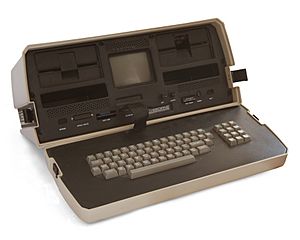Adam Osborne facts for kids
Quick facts for kids
Adam Osborne
|
|
|---|---|
 |
|
| Born | March 6, 1939 Bangkok, Thailand
|
| Died | March 18, 2003 (aged 64) Kodaikanal, India
|
| Alma mater | |
| Known for | Osborne 1 |
| Scientific career | |
| Fields | Computer Engineering |
| Institutions | Osborne Computer Corporation |
Adam Osborne (born March 6, 1939 – died March 18, 2003) was a British-American author, publisher, and computer designer. He started several companies in the United States and other places. He is best known for introducing the Osborne 1. This was the first portable computer that sold very well.
Contents
Early Life
Adam Osborne was born in Bangkok, Thailand, on March 6, 1939. His father was British and his mother was Polish. His father, Arthur Osborne, was a teacher. The family lived in southern India during World War II. They all spoke the Tamil language fluently.
Adam went to school in Kodaikanal, India, until he was about 11. In 1950, his family moved to England. He went to different schools there. He later earned a degree in chemical engineering from the University of Birmingham in 1961. He then got his PhD from the University of Delaware in 1968. While living in the United States, he learned how to write computer code.
Publishing Books
Adam Osborne was a pioneer in the world of computer books. In 1972, he started a company that made computer manuals. These books were easy to read and understand. By 1977, his company, Osborne & Associates, had 40 different book titles.
In 1979, a big company called McGraw-Hill bought his company. It continued to publish books under the name "McGraw-Hill/Osborne." Adam Osborne also wrote several books himself. One of his books, An Introduction To Microcomputers, sold 300,000 copies.
Making Computers
Adam Osborne was a regular at the Homebrew Computer Club meetings around 1975. He created the first portable computer that was sold to many people. This computer was called the Osborne 1. It came out in April 1981.
The Osborne 1 weighed about 24.5 pounds (12 kg). It cost $1795, which was much less than other computers at the time. It used a popular operating system called CP/M 2.2. The computer was designed to fit easily under an airline seat. At its best, Osborne Computer Corporation shipped 10,000 units of the Osborne 1 every month.
Adam Osborne was one of the first people to realize that many buyers were not just computer experts. The Osborne 1 came with important software like word processing and spreadsheet programs. This was different from other companies like IBM. IBM sold their computers, operating systems, and even cables separately.
Adam Osborne's background in the computer industry helped his new company. Advertisements for Osborne Computer Corporation compared Adam Osborne's impact on computers to Henry Ford's impact on cars.
However, in 1983, Osborne reportedly talked about two new, more advanced computers his company was working on. These announcements made people stop buying the Osborne 1. This caused a huge number of unsold computers. Because of this, Osborne Computer had to declare bankruptcy on September 13, 1983. This problem, where announcing a new product too early hurts sales of older ones, is called the Osborne effect. But some say the real reasons for the bankruptcy were mistakes in management and not enough money.
Writing About Growth
After his computer company closed, Adam Osborne wrote a popular book. It was called Hypergrowth: The Rise and Fall of the Osborne Computer Corporation. He wrote it with John C. Dvorak. The book came out in 1984.
Software Companies
In 1984, Osborne started a new company called Paperback Software International Ltd.. This company focused on selling computer software that was not expensive. Adam Osborne himself appeared in their advertisements. He argued that software was too costly.
One of their products was VP-Planner. It was a cheaper version of a popular program called Lotus 1-2-3. This led to a lawsuit. In 1987, Lotus sued Paperback Software. Because of the lawsuit, people lost trust in Paperback Software. Their sales dropped a lot by 1989. This made it hard for the company to get money to grow.
In February 1990, the case went to court. On June 28, the court decided that Paperback Software had copied Lotus 1-2-3's menu style. This was against Lotus's copyright. Adam Osborne left Paperback Software that same year. However, another program from Paperback, called VP-Info, continued to sell well for many years.
His last business idea was in 1992. He started a company called Noetics Software. This company worked on artificial intelligence, which is about making computers think like humans.
Personal Life and Passing
Adam Osborne was a member of Mensa, a group for very intelligent people. He was married and divorced twice. He had three children. His former wives and all his children survived him.
In 1992, Adam Osborne moved back to India. His health was getting worse. He had a brain disorder that caused him to have many small strokes. He passed away peacefully in his sleep on March 18, 2003, in Kodaikanal, India. He was 64 years old.
See also
 In Spanish: Adam Osborne para niños
In Spanish: Adam Osborne para niños


